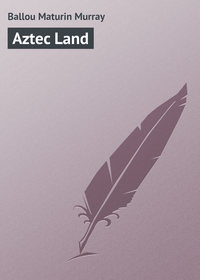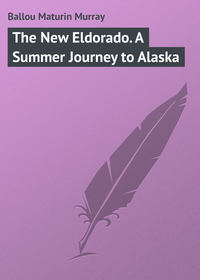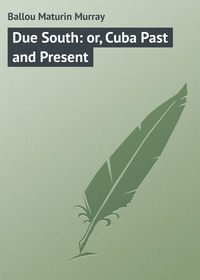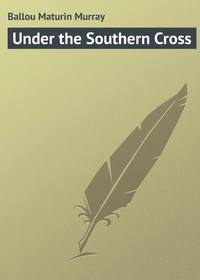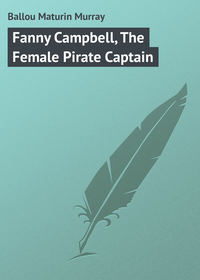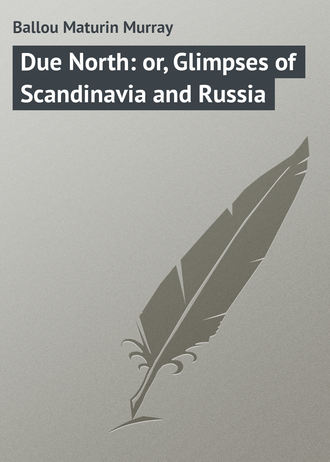 полная версия
полная версияDue North: or, Glimpses of Scandinavia and Russia
Nothing can be pleasanter or more exhilarating than driving over the Norwegian roads among the dark pine forests or by the side of dashing torrents and swift-gliding, seething rivers. The roads are kept in perfect condition upon all of the regular post-routes, and one rolls over them in the native carriole nearly as smoothly as though navigating a lake in a well-manned boat. The little horses, almost universally of a dun-color and having their manes cropped short, are wiry and full of life and courage, dashing down the hills at a seemingly reckless pace, which carries the vehicle half way up the next rising ground by the mere impetus of the descent. It was particularly gratifying to observe the physical condition of the horses both inland and in the streets of Christiania, all being in good flesh. Not a lame or poor animal was to be found among them, either in hack, dray, or country-produce cart. They are mostly pony-shaped, rather short in the legs, few standing over fourteen hands, and generally even less; but yet they are strong, tough, and round in form. It was pleasing to observe the drivers, who seemed also to be the owners, of these animals. When they came from the house or establishment where their business called them, they would often take some appetizing trifle from their pockets, – a small apple, a lump of sugar, or bit of bread, – and tender it to the waiting horse, who was evidently on the look-out for such a favor. The good fellowship established between the animal and his master was complete, and both worked the more effectively together. No observant person can fail to see what docility and intelligence kindness to any domestic animal is sure to elicit, while brutality and harshness induce only reluctant and inefficient service. If the whip is used at all upon these faithful animals it must be very uncommon, since a watchfulness in regard to the matter did not discover a single instance. When a driver has occasion to stop before a house and leave his horse, he takes one turn of the rein about the animal's near fore-foot and secures the long end loosely to the shaft. Custom has taught the horses that this process ties them to the spot, and they do not attempt to move away under any circumstances. Insects during the brief but intense heat of summer are very troublesome to animals exposed to their bite, and so the Norwegian horses are all wisely permitted to wear long tails as a partial defence against flies and gnats. The price at which they are valued is very moderate. A nicely-matched pair, quite sound, young, and well broken for pleasure driving, can be purchased for three hundred dollars or less.
Between Christiania and Stockholm the railroad follows almost a straight line due east across southern Norway and Sweden through a country dotted over with little hamlets of a dozen houses more or less, occupied by thrifty farmers. The people are of a social, kindly disposition, but to be known among them as an American insures instant service, together with unlimited hospitality. Nearly every family has one or more representatives living in the United States, and the very name of America is regarded by them with tenderness. A large percentage of the young people look forward to the time when they shall eventually make it their permanent home. Emigration is neither promoted nor discouraged by the Government. Norway seems generally to be more fertile than Sweden. True, she has her numerous mountains, but between them are far-reaching and beautiful valleys, while the sister country with less elevations has a soil of rather a sandy nature, much less productive. But intelligent farming overcomes heavy drawbacks; and there are large tracts of land in Sweden that are rendered quite remunerative through the adoption of modern methods of cultivation. Immediately about the railroad stations on all the Scandinavian railroads there are fine gardens, often ornamented with fountains, bird-houses, blooming flowers, and miniature cascades. Some of the combinations of floral colors into graceful figures showed the hand of experienced gardeners. Most of these station-houses, all of which are constructed of wood, are extremely picturesque, built in chalet style, rather over-ornamented by fancy carvings and high colors, yet well adapted in the main for their special purpose. The Government owns and operates three quarters of all the railroads in either country, and will doubtless ere long, as we were assured, control the entire system.
In the rural districts women are very generally employed upon out-of-door work, as they are in Germany and Italy, and there is quite a preponderance of the sex in both Norway and Sweden. It was the haying and harvesting season when the author passed over the principal routes, and the fields showed four times as many women as men engaged in mowing, reaping, loading heavy carts, and getting in the harvest generally. What would our New England farmers think to see a woman swing a scythe all day in the haying season, cutting as broad and true a swath as a man can do, and apparently with as little fatigue! Labor is very poorly paid; forty cents per day is considered liberal wages for a man except in the cities, where a small increase is realized upon this amount. The houses all through Norway outside of the towns are built of logs, well-matched and smoothly finished, laid horizontally one upon another, like our frontier cabins in the far West. Each farm, besides the home acres, has also connected with it what is termed a "sæter," being a tract of mountain pasture, where a portion of the young members of the family (usually the girls only) pass the nine or ten weeks of summer engaged in cheese-making, the cattle being kept on the hills for that period. Here a very rude hut with but two apartments serves for the girls, and a rough shed for the cattle at night. The outer apartment of the hut contains a stove, a table, and a coarse bed, forming the living-room, while the inner one is improved for the dairy. The available soil about the home farm in the valley must raise hay and grain for the long winter's use. After being milked in the morning, at the sæter, the cows, goats, and sheep go directly to their allotted feeding ground, perhaps more than a mile away, and at the evening hour they by themselves as surely return to be milked. The only inducement for such regularity on the part of the intelligent creatures, so far as we could understand, was a few handfuls of salt which was given them nightly, and of which they seemed to be very fond. Great exertion is made by the girls in the mountains to excel one another as to the aggregate production of cheese for the season, much pride being felt also in the quality of the article. The sturdy figures and healthy blooming faces of these girls, "with cheeks like apples which the sun has ruddied," showed what physical charms the bracing mountain air and a simple manner of life in these regions is capable of producing.
Norway has been appropriately called the country of mountains and fjords, of cascades and lakes. Among the largest of the latter is Lake Mjösen, which is about sixty miles long and has an average width of twelve. It is certainly a very remarkable body of water. It receives into its bosom one important river, the Lougen, after it has run a course of nearly a hundred and fifty miles. At its southern extremity is the port of Eidsvold, and at the northern is Lillehammer. These are situated in the direct route between Christiania and Tröndhjem. But the most singular fact attached to the lake is that it measures over fifteen hundred feet in depth, while its surface is four hundred feet above the level of the ocean. Its bottom is known to be nearly a thousand feet below that of the North Sea, which would seem to show that it must be the mouth of some long-extinct volcano. Neither glacial action nor any other physical agent known to us can have dug an abrupt hole eight or ten hundred feet deep; and yet there are also some dry valleys in Norway whose bottoms are considerably below that of the sea. The river Mesna tumbles boisterously into the lake close to Lillehammer. A walk beside its thickly-wooded banks brings to view many beautiful cascades and waterfalls, some of which are worthier of a visit than many of the more famous falls of Scandinavia. On all the important inland routes not furnished with railroad or steamboat transit Government supports a system of postal service, whereby one can easily travel in almost any desired direction. On such excursions the keen air and free exercise are apt to endow the traveller with an excellent appetite, which Norwegian fare is not quite calculated to assuage. However, the milk is almost always good, and eggs are generally to be had. Even hard black bread will yield to a hammer, after which it can be soaked in milk and thus rendered eatable. One does not come hither in search of delicate and appetizing food, but rather to stand face to face with Nature in her wildest and most rugged moods. The pleasures of the table are better sought in the big capitals of southern Europe or America, where "rich food and heavy groans go together."
As to the fauna of Norway, the reindeer, the bear, the wolf, the fox, and the lynx about complete the list of indigenous animals. The ubiquitous crow abounds; and fine specimens of the golden eagle, that dignified monarch of the upper regions, may occasionally be seen sailing through the air from cliff to cliff, across the fjords and valleys. At certain seasons of the year this bird proves destructive to domestic fowls and young lambs. But we escaped in Norway the almost inevitable legend of a young child having been carried off by an eagle to its nearly inaccessible nest; that story is still monopolized by Switzerland. For some reason not quite understood by the author, the mischievous magpie is here held as half sacred. That is to say, the country people have a superstition that any injury inflicted upon these birds entails misfortune upon him who causes it; and yet the Government offers a premium for their destruction. Magpies appear to be as much of a nuisance in Norway as crows are in India or Ceylon, and to be quite as unmolested by the people generally. What are called the wild birds of Scandinavia are in fact remarkably tame, and they embrace a large variety. As the traveller proceeds through the country, he will observe sheaves of unthrashed grain elevated upon poles beside the farm-houses and barns, which are designed to furnish the feathered visitors with food. These sheaves are regularly renewed all through the winter season; otherwise the birds would starve. The confiding little creatures know their friends, and often enter the houses for protection from the severity of the weather. Neither man, woman, nor child would think of disturbing them, for they are considered as bringing good luck to the premises which they visit. The bounty paid for the destruction of bears and wolves in 1885 showed that nearly two hundred of each species of these animals were killed by the hunters. Bears are believed to be gradually decreasing, but wolves are still very numerous in the northerly regions and the thickly-wooded middle districts. In extreme seasons, when pressed by hunger, they prove destructive to the reindeer herds of the Lapps in spite of every ordinary precaution, and even in the summer season farmers never leave their sheep unguarded when they are pastured away from the homestead.
In journeying from the capital to Tröndhjem (where the steamer is taken for the North Cape) by the way of Lillehammer, one crosses the Dovrefjeld, or mountain plateau; but a more popular route is by rail from city to city. This fjeld lies a little above the sixty-second parallel of latitude, and is about one third of the distance from the southern to the northern extreme of the country, which reaches from the fifty-eighth to the seventy-first parallel. The famous elevation called the Sneehaettan – "Snow Hat" – forms a part of this Alpine range, and is one of the loftiest in Norway, falling little short of eight thousand feet in altitude. To be exact, it ranks sixth among the Scandinavian mountains. It should be remembered that one eighth of the country lies within the region of perpetual snow, and that these lofty and nearly inaccessible heights are robed in a constant garb of bridal whiteness. No other part of Europe or any inhabited portion of the globe has such enormous glaciers or snowfields, unless possibly some portions of Alaska. Here in Norway are glaciers which cover from four to five hundred square miles, descending from plateaus three and four thousand feet in height down to very near sea-level, as in the instance of the mammoth Svartisen glacier, which is visited by all travellers to the North Cape. Arctic and Alpine flowers abound in the region of the Dovrefjeld, – and glacial flowers are abundant, though not so much so as in the more frequently visited snow regions of Switzerland. As the ice and snow recede in the early summer, the plants spring up with magic promptness, so that within a few yards the same species are seen in successive stages of growth, spring and summer flowers blooming side by side in rather forced companionship. The blue gentians are extremely lovely, and are among the first to appear after the mantle of snow is lifted from the awaking earth. The most remarkable and abundant of the spring flowers however is the linnæa borealis, thus appropriately named after the great Swedish botanist and naturalist. It is a long, low-creeping plant bearing a pink blossom, and is in full bloom early in July, luxuriating all over the Scandinavian peninsula. Harebells nodding upon their delicate stems, primroses, snowdrops, and small blue pansies are also common. In the southern districts roses of various species thrive in glorious profusion in the open air annually during the short genial period, and also as domestic favorites during the long night of winter, adorning and perfuming the living-rooms of the people of every class in town and country.
Though the highest point in Norway or Sweden is only about eighty-five hundred feet above sea-level, an elevation which is reached only by the Jotunfjeld, or Giant Mountain, still no highlands in Europe surpass those of Scandinavia in terrific and savage grandeur, "rocked-ribbed and ancient as the sun." Mont Blanc is fully one third higher than this Giant Mountain, but being less abrupt is hardly so striking and effective in aspect. The grand elevations of Norway are intersected by deep dark gorges and fearful chasms, roaring with impetuous torrents and enormous waterfalls, and affording an abundance of such scenes as would have inspired the pencil of Salvator Rosa. The mountain system here does not form a continuous range, but consists of a succession of plateaus like the Dovrefjeld, and of detached mountains rising from elevated bases. The length of this series of peculiar elevations – mountains and plateaus – is that of the entire peninsula, from the North Cape to Christiansand on the Skager Rack, some twelve hundred miles, having an average width of about two hundred miles, – which gives to the mountains of Norway and Sweden an area larger than the Alps, the Apennines, and the Pyrenees combined, while the lakes, waterfalls, and cascades far surpass those of the rest of Europe. There is no other country where so large a portion is covered with august mountains as in Norway. It includes an area of about one hundred and twenty-three thousand square miles; and it has been said by those most familiar with its topography, that could it be flattened out it would make as large a division of the earth as would any of the four principal continents. The ratio of arable land to the entire area of Norway is not more than one to ten, and were it not that the support of the people at large comes mainly from the sea, the country could not sustain one quarter of even its present sparse population. Undismayed by the preponderance of rocks, cliffs, and chasms, the people utilize every available rod of land. Here and there are seen wire ropes extending from the low lands to the mountain sides, the upper ends of which are lost to sight, and which are used for sliding down bundles of compressed hay after it has been cut, made, and packed in places whither only men accustomed to scale precipices could possibly climb. The aspect of such regions is severe and desolate in the extreme, even when viewed beneath the cheering smiles of a summer sun. What then must be their appearance during the long, trying winter of these hyperborean regions? In snug corners, sheltered by friendly rocks and cliffs from the prevailing winds, are seen little clusters of cabins inhabited by a few lowly people who live in seeming content, and who rear families amid almost incredible deprivations and climatic disadvantages, causing one to wonder at their hardihood and endurance. It is not uncommon to see along the west coast of Norway, among the islands and upon the main-land, farm-houses surrounded by a few low buildings of the rudest character, perched among rocks away up on some lofty green terrace, so high indeed as to make them seem scarcely larger than an eagle's nest. To anybody but a mountaineer these spots are positively inaccessible, and every article of subsistence, except what is raised upon the few acres of available earth surrounding the house, must be carried up thither upon men's backs, for not even a mule could climb to these regions. A few goats and sheep must constitute the entire animal stock which such a spot can boast, with perhaps a few domestic fowls. These dwellings have been constructed of logs cut in some of the sheltered gulches near at hand and drawn to the spot with infinite labor, one by one. It would seem that such persistent and energetic industry applied in more inviting neighborhoods would have insured better results. What must life be passed in such an isolated, exposed place, in a climate where the ground is covered with snow for nine months of each year! Some few of these eyries have bridle-paths leading up to them which are barely passable; and yet such are thought by the occupants to be especially favored.
CHAPTER V
Ancient Capital of Norway. – Routes of Travel. – Rain! – Peasant Costumes. – Commerce of Bergen. – Shark's vs. Cod Liver Oil. – Ship-Building. – Public Edifices. – Quaint Shops. – Borgund Church. – Leprosy in Norway. – Sporting Country. – Inland Experiences. – Hay-Making. – Pine-Forest Experiences. – National Constitution. – People's Schools. – Girls' Industrial School. – Celebrated Citizens of Bergen. – Two Grand Norwegian Fjords. – Remarkable GlaciersBergen is situated some two hundred miles northwest of Christiania, and may be reached from thence by a carriole journey across the country over excellent roads, or by steamboat doubling the Naze. The latter route, though three times as far, is often adopted by travellers as being less expensive and troublesome. Still another and perhaps the most common route taken by tourists is that by way of Lake Mjösen, Gjöveg, the Fillefjeld and Laerdalsören, on the Sognefjord. This is called the Valders route, and affords by far the greatest variety of scenery. It involves railroad, steamer, and carriole modes of conveyance, and in all covers a distance of at least three hundred and fifty miles. It will be remembered that Bergen was the capital of Norway when it was under Danish rule, and was long afterwards the commercial rival of Christiania. Indeed, its shipping interests we were informed still exceed those of the capital, the verity of which statement one is inclined to question. The period of its greatest prosperity was in the Middle Ages and during the century when the great Hanseatic League flourished, at which time there was a numerous German colony resident here. The town appears very ancient, and naturally so, as it dates back to the eleventh century. Many of the dwellings are quaint with sharp-peaked roofs and gable-ends toward the streets. The boats which ply in the harbor and throng the wharves differ but little from the style of those used by the Norse pirates a thousand years ago, and who congregated in force about these very shores. The oldest part of the city lies on the eastern side of the harbor where the fortress of Bergenhuus and the double-towered Maria Kirke are situated. The inhabitants are not amphibious, but they certainly ought to be, since it rains here five days out of every seven. Some one has aptly called it the fatherland of drizzle, "where the hooded clouds, like friars, tell their beads in drops of rain." The first and foremost business of the place, therefore, is dealing in umbrellas and water-proof clothing. We did not observe any special crest as indicating the corporate arms of the city, but if such a design exists, it should be surmounted by a full-length figure of Jupiter Pluvius. We were assured that the rain-fall here averages six feet annually. There is a tradition of sunny days having occurred in Bergen, but much patience and long waiting are necessary to verify it. Still there is plenty of life and business activity in the broad clean streets, and more especially in and about the wharves and shipping.
One sees here more of the traditional Norwegian costumes than are to be met with either at Gottenburg or Christiania. Some of the old men who came from the inland villages were particularly noticeable, forming vivid and artistic groups, with their long snowy hair flowing freely about face and neck in the most patriarchal fashion. They wore red-worsted caps, open shirt-collars, knee-breeches, and jackets and vests decked with a profusion of silver buttons, like a Basque postilion. The women wear black jackets, bright-red bodices and scarlet petticoats, with white linen aprons. On the street called the Strandgade many Norse costumes mingle together like colors in a kaleidoscope. Our guide pointed out one group, which was perhaps more strongly individualized than the rest, as coming from the Tellemark district. Various nationalities were also represented, not forgetting the despised and much persecuted Jews, who are nearly as unpopular in Scandinavia as they are in Germany and Russia. The Strandgade is the longest thoroughfare in the city, and runs parallel with the harbor. By turning to the left after reaching the custom-house and passing up the rising ground, one reaches the Observatory, from whence a fine view of Bergen and its environs is obtained. The dusky red-tiled roofs crowded together, the square wooden towers of the churches mingled with the public gardens dressed in warmest verdure, form altogether a quaint and impressive picture. The town rises from the bay nearly in the form of a crescent, nestling at the feet of the surrounding hills on the west coast of Norway, between those two broad and famous arms of the sea, the Sognefjord and the Hardangerfjord. The first named indents the coast to a distance of one hundred and six miles, the latter seventy miles, – the first being north, and the last south of Bergen. The excellent situation of the harbor and its direct steam communication with European ports give this ancient city an extensive commerce in proportion to the number of inhabitants, who do not aggregate more than forty thousand. A large portion of the town is built upon a promontory, and between it and the main-land on its north side is the harbor, which is rarely frozen over owing to the influence of the Gulf Stream, while the harbor of St. Petersburg, in about the same latitude, is annually closed by ice for at least three months.
The staple commodity of Bergen is dried fish, mostly cod, supplemented by large quantities of cod-liver oil, lumber, and wood for fuel. It may not be generally known that a considerable portion of what is denominated cod-liver oil is produced from sharks' livers, which in fact are believed to be characterized by the same medicinal qualities as are those of the cod. At any rate, with this object sharks are sought for along the upper coast of Norway in the region of the Lofodens, and their livers are employed as described. An average-sized shark, we were told, will yield thirty gallons of good merchantable oil, but the article could not obtain a market except under the popular name of cod-liver oil. Catching the sharks is not an employment entirely devoid of danger, as they are often found to be large and very powerful, measuring from twenty-five to thirty feet in length. The shark like the whale, when it is struck with the harpoon, must at first be given plenty of line or it will drag down the boat in its rapid descent to deep water. Sometimes the struggle to capture the fish is a long and serious one, as it must thoroughly exhaust itself before it will yield. When finally drawn to the side of the boat, a heavy well-directed blow upon the nose completely stuns the creature, and the capture is then complete. The diminution in the number of sharks upon the coast has led to a large natural increase in the number of herring, the catching of which forms a special and profitable branch of Norwegian industry.



